
Busan, officially known as Busan Metropolitan City, is South Korea's second most populous city after Seoul, with a population of over 3.4 million inhabitants as of 2017. Formerly romanized as Pusan, it is the economic, cultural and educational center of southeastern South Korea, with its port being South Korea's busiest and the sixth-busiest in the world. The surrounding "Southeastern Maritime Industrial Region" is South Korea's largest industrial area. The large volumes of port traffic and urban population in excess of 1 million make Busan a Large-Port metropolis using the Southampton System of Port-City classification.

Yongin is a city in the Seoul Capital Area, the largest in Gyeonggi Province, South Korea. With a population over 1 million, the city has developed rapidly since the 21st century, recording the highest population growth of any city in the country. Yongin is home to Everland and Caribbean Bay, South Korea's most popular amusement and water parks. The city is also home to the Korean Folk Village, the largest of its kind. Yongin-si is a multi-nuclear city with multiple urban centers, not a single nuclear structure, and Giheung-gu crosses the Yeongdong Expressway and Dongbaek, while Suji-gu crosses Pungdeokcheon Stream and Jukjeon.
South Korea is made up of 17 first-tier administrative divisions: 6 metropolitan cities, 1 special city, 1 special self-governing city, and 9 provinces, including two special self-governing provinces. These are further subdivided into a variety of smaller entities, including cities, counties, districts, towns, townships, neighborhoods and villages.

Bucheon is a city in Gyeonggi Province, South Korea. Bucheon is located 25 kilometers (16 mi) away from Seoul, of which it is a satellite city. It is located between Incheon and Seoul.

Goyang is a city in Gyeonggi Province in the north of South Korea. It is part of the Seoul Capital Area, making Goyang one of Seoul's satellite cities. It is one of the largest cities in the Seoul Capital Area, with a population of just over 1 million. Ilsan, a planned city, is located in the Ilsandong-gu and Ilsanseo-gu districts of Goyang. It also includes Deogyang-gu which is closer to Seoul.

Gwangmyeong is a city in Gyeonggi Province, South Korea. It borders Seoul to the east, north and northeast, Anyang to the southeast, Siheung to the southwest, and Bucheon to the northeast.
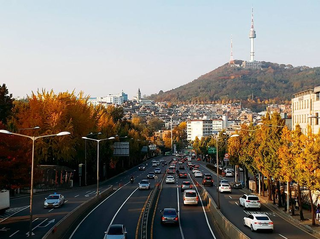
Yongsan District is one of the 25 districts of Seoul, South Korea.
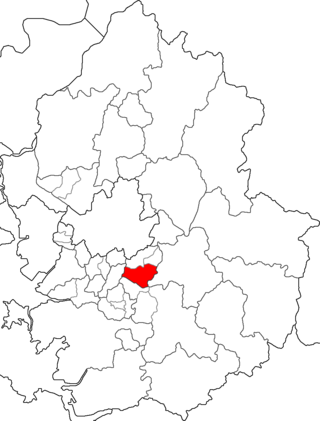
Bundang-gu is the largest and most populous district (gu) of Seongnam, a major city in the Seoul Capital Area, South Korea. Bundang-gu is one of South Korea's wealthiest and highest developed areas, being the nation's first and largest completely artificial city built in the early 1990s. Many high-rise luxury condos moved in the early 2000s, with a second planned city built in the late 2000s called Pangyo in the same district. Apartment prices are the second highest in Gyeonggi-do after Gwacheon and 7th highest nationwide, higher than many central Seoul districts such as Mapo-gu or Jongno-gu. Apartments around Pangyo station and the high-rise luxury condos around Jeongja station and Sunae station rival prices in the most expensive areas in the country. Unlike older cities such as Seoul, Bundang has no telephone poles overground, resulting in a clean cityscape with well-designed streets.

Yeongdeungpo District is an administrative district in southwest Seoul, South Korea. Although the origin of the name is uncertain, the first two syllables are thought to be from "yeongdeung" (靈登) or "divine ascent", a shamanic rite. The third syllable is "po", representing the bank of a river (浦), referring to the district's position on the Han River. The 2006 population was 408,819.

Yeouido is a large island on the Han River in Seoul, South Korea. It is Seoul's main finance and investment banking district. It is 8.4 square kilometres (3.2 sq mi) large and has a population of 32,674 as of August 2023.

Seocho District is one of the 25 local government districts which make up the city of Seoul, South Korea. Seocho is a part of the Gangnam region, along with the Gangnam district of Seoul. Seocho District ranks as one of the richest neighborhoods in South Korea and among the most expensive areas in Seoul with an average sales price of 47.75 million South Korean won per 3.3 square meters. Many of the wealthiest residents are concentrated in the three Gangnam districts including Seocho, known as Gangnam School District Eight.
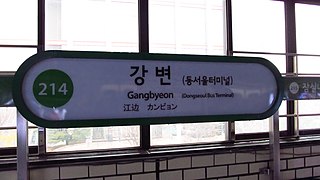
Gangbyeon Station is a station on the Seoul Subway Line 2. The name of this station literally means "riverside," pertaining to its proximity to the Han River.

Gwangjin District is one of the 25 districts of Seoul, South Korea. It is located on the north bank of the Han River on the eastern end of Seoul. The district was split from the neighboring Seongdong District in 1995.

Seocho-dong is a dong, or neighborhood of the greater Gangnam area Seocho-gu district of the South Korean city of Seoul. Seocho-dong is divided into 4 different dong which are Seocho 1-dong, 2-dong, 3-dong and 4-dong. The main street is Teheranno. There is Gangnam Station in Seocho-dong, which is one of the biggest stations in Korea.
Seoul, the capital and largest city in South Korea, accounts for only 0.6% of the country's total land area, yet it is home to around 19% of the population. The population density in Seoul demands a great deal of the city's transportation systems, which are regarded by many as among the best and most advanced in the world. Seoul is very well connected by its subway and bus systems, and the city is also very supportive of pedestrian foot travel. In 2006 it won the Sustainable Transport Award.
Myeongil-dong is a dong, neighbourhood of Gangdong-gu in Seoul, South Korea.

Jamwon-dong is a dong, neighbourhood of the greater Gangnam area Seocho-gu in Seoul, South Korea. Until 1988, Jamwon-dong was under the jurisdiction of Gangnam-gu. Jamwon-dong is popular for its mulberry trees and silkworms, whose cocoon is used to make fabric for clothing. As a legal-status neighborhood, Jamwon-dong includes Banpo 3-dong and Jamwon-dong.

Banpo-dong is a dong, neighborhood of Seocho-gu, the greater Gangnam area in Seoul, South Korea. Banpo-dong is divided into five different dong which are Banpobon-dong, Banpo 1-dong, 2-dong, 3-dong and 4-dong.
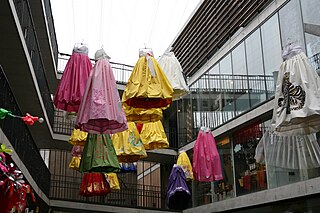
Seoul, the capital of South Korea, has many shopping areas and markets throughout the city. Famous ones include Myeong-dong, Cheongdam-dong, the Hongdae area, and the Dongdaemun and Namdaemun markets.
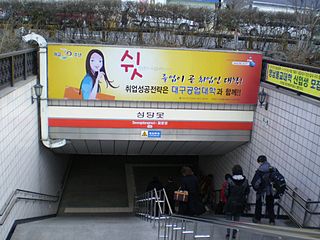
Seobu Bus Terminal Station is a station of a city railroad of Daegu Metro Line 1 in Nam-gu Daegu, South Korea. There is a large floating population because of the marketplace and clothing business around the terminal that is connected with Seobu Bus Terminal Station. Seobu should not be confused with Seodaegu Express Bus Terminal, even though both mean West (Daegu). Be wary when booking transport tickets when using either bus terminal. The latter has an adjoining metro station ; both are located further north from Seobu.
















